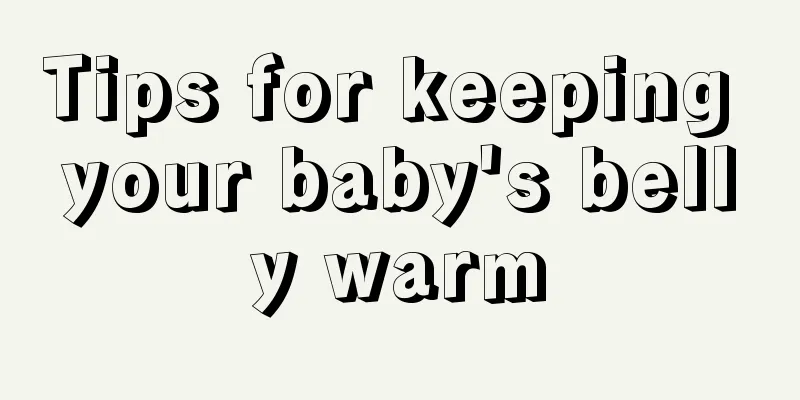Tips for keeping your baby's belly warm

|
The physical health of the baby is very important because children are young and often have low resistance or immunity. Therefore, it is possible for diseases to occur, especially in the baby's abdomen, which may be affected by some external factors for a long time and lead to diseases. For example, if the abdomen catches a cold, it is easy to cause diarrhea and other diseases. Therefore, we should protect the child’s abdominal health. So what are some tips for keeping the baby’s abdomen warm? 1. Abdominal pain and diarrhea caused by cold stomach Why is the baby's belly so important? The reason is simple. The internal organs responsible for the physiological function of the human body are all hidden in the belly. How can we not protect it well? The baby's upper abdomen has little fat and the abdominal wall is relatively thin, especially around the belly button. Once the stomach is exposed to cold, it is very easy to develop diseases such as stomach pain, indigestion, and diarrhea. This area is large, the blood vessels in the skin are densely distributed, and the body surface dissipates heat quickly. If this area is exposed in cold weather, the blood vessels in the abdominal cavity will immediately contract, and it may even cause the stomach to contract strongly and cause severe pain that lasts for a while, just like a cold in the neck. The sympathetic-adrenal and other neuroendocrine systems throughout the body will also react strongly, causing various diseases. Therefore, in winter, special attention must be paid to keeping the baby's abdomen warm, so that the spleen and stomach can function normally and stably, and promote the digestion and absorption of food. 2. Bellyband, keep your belly warm in style In order to keep your baby's belly warm in the most reliable way, your baby's belly needs all-round and multi-level protection in winter, and how to dress and sleep is very important! Bellyband, baby high waist pants, belly protection pants During the day or when sleeping, it is best for smaller babies to wear a small belly band so that no matter how much they wear, their belly will not be exposed and catch a cold. If you are not used to wearing belly bands, you can also consider high-waisted baby pants, belly protection pants, and one-piece pajamas. These practical baby clothes can completely protect the little belly. No matter how the baby turns over in sleep, the mother does not have to worry about the baby kicking off the quilt and catching a cold belly. In addition, for older babies, it is best to wear longer tops during the day that completely cover the abdomen. If you go out, it is best to tuck your child's clothes into his or her pants to prevent the child from catching a cold by exposing his or her belly when the clothes are pulled when you hold the child or when the child is playing by himself or herself. Large bath towel, blanket, dad's clothes Don’t forget your stomach when you go to sleep. You can use a large bath towel or a thin blanket, fold it in half into several layers, and cover the baby's abdomen with it, leaving his hands and feet exposed. This will prevent the baby from kicking off the bath towel or thin blanket when he falls asleep or turns over. Press the quilt, fold it, put one-third of it under the baby's body, and cover it with two-thirds. Mom and dad can sleep next to the baby and put the quilt under their bodies. What does dad's clothes have to do with keeping the baby warm? Dad's coat is usually larger. Choose soft clothes to put on the baby, and then cover it with a quilt, and you have a DIY simple sleeping bag! *Warm tips: Keep the baby warm enough. The quilt you cover your baby with should not be too thick or too tight, otherwise the baby will get too hot and kick it off. Tummy care rules for babies of different ages Babies need to protect their tummies at all times, and the warmth needs of children of different ages are slightly different. Mothers can also dress their babies based on this! Newborns (0-28 days): During this period, babies move less and need to be wrapped more. Pay attention to wiping off sweat on their backs in time. The belly button has not yet grown, so keep the belly warm and protect the belly button. At the same time, don't forget that the room temperature should be suitable for your baby, it is best to keep it around 24 degrees Celsius. Infants (1-12 months): Babies at this age like to move, roll, and crawl, especially those approaching 1 year old. Pay attention to wearing belly clothes properly. You can choose jumpsuits, high-waisted pants, and separate tops and bottoms. It is recommended to pull the pants up above the clothes. Toddlers (over 12 months old): Babies at this age can walk, like to play outdoors, and sweat easily, so be sure to use a sweat towel. In winter, they can wear a slightly longer coat or vest to cover their buttocks and stomach, so that their waist and stomach are not easily exposed when jumping. In order for children to dress appropriately, it is also necessary to consider their physical condition. Mothers can check their baby’s temperature by checking two areas: the tip of the nose and the ridge of the shoulders. There is a dressing motto to remember: Wearing too little: no sweat on shoulders and back, cool nose Wearing too much: sticky shoulders and back, warm nose Just enough to keep your shoulders dry and your nose warm In short, don't let your baby catch a cold! Let me say a few more words. When the ambient temperature is too low, you can use a hot water bottle for hot compress, but you should control the temperature to avoid scalding the baby; drink some hot drinks or rub the baby's abdomen with warm hands; also give the baby some Yitong probiotics, which are very effective for baby's indigestion and diarrhea, and are pure natural with no side effects. |
<<: What to do if a child has a bacterial fever?
>>: Why does my baby have hot hands and feet but a cold neck when sleeping?
Recommend
Preventive nursing of neonatal adrenal hyperplasia
When caring for newborns, parents must do so comp...
What are some good folk remedies for newborn babies with prickly heat?
Newborns should pay attention to keeping warm and...
What causes a baby's heart murmur?
Every newborn baby is an extremely precious treas...
Does umbilical hernia affect the baby? Moms, please watch carefully!
Many people do not understand the various disease...
How to help children lose weight?
In life, many parents hope that their children ar...
Treatment of pharyngeal follicles in children
As parents, when our children develop pharyngeal ...
Why are my children's teeth yellow?
When we communicate with others, the first thing ...
What is the reason for the baby's thumb to bend inward?
Babies are the apple of their parents' eyes a...
How old can babies swim?
Newborn swimming is a popular lifestyle nowadays....
What should I do if my child can’t hold his urine?
Normally, many children have varying degrees of d...
How much sleep does an 80-day-old baby need?
I believe that many people think of babies as &qu...
What is the normal development age for boys?
With the continuous improvement of living standar...
What’s going on with the little red spots on my baby’s mouth?
The baby's every move concerns the parents, a...
What to do if your baby has a viral rash
In life, many people do not have a real understan...
Warm-up exercise methods for children
The physical fitness of many young children is ge...









